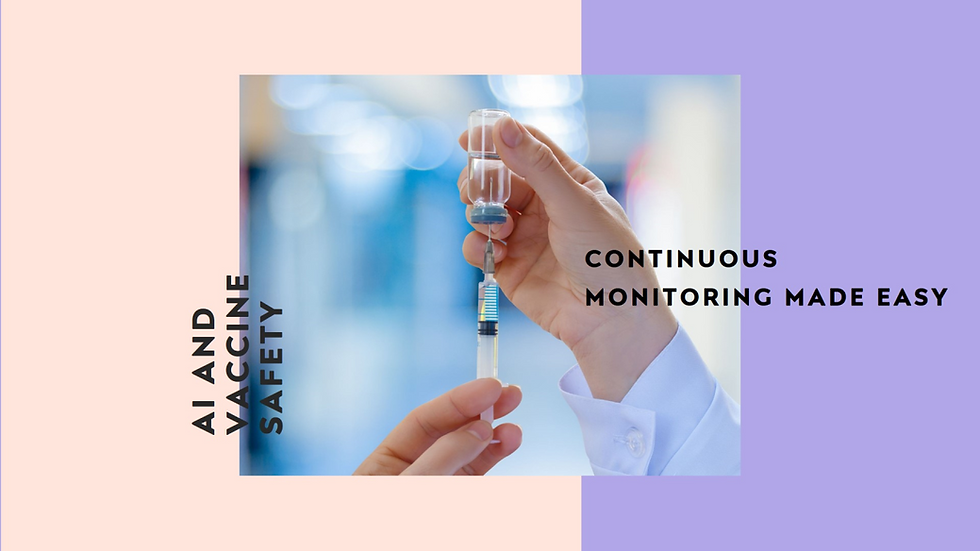
Artificial Intelligence (AI) is revolutionizing vaccine safety monitoring by enabling continuous, real-time analysis of vast amounts of data. This blog explores the role of AI in enhancing vaccine safety surveillance, its applications in signal detection, adverse event monitoring, and the challenges and opportunities AI presents in ensuring the safety and efficacy of vaccines.
Introduction to AI in Vaccine Safety:
AI technologies, including machine learning algorithms and natural language processing (NLP), have significantly transformed healthcare surveillance systems. In the context of vaccine safety, AI plays a crucial role in:
Real-Time Data Analysis: Processing large volumes of data quickly and efficiently.
Pattern Recognition: Identifying complex patterns and associations that may indicate potential safety concerns.
Automated Signal Detection: Detecting signals of adverse events that may not be immediately apparent through traditional surveillance methods.
Enhanced Decision Support: Providing actionable insights to healthcare providers, regulators, and policymakers for timely intervention.
The Importance of Continuous Monitoring:
Continuous monitoring of vaccine safety is essential for several reasons:
Early Detection of Adverse Events: Identifying potential safety issues early allows for prompt investigation and intervention.
Improving Public Confidence: Transparent and proactive monitoring helps maintain trust in vaccination programs.
Regulatory Compliance: Meeting regulatory requirements for post-marketing surveillance and reporting of adverse events.
Enhancing Vaccine Development: Informing future vaccine development by providing insights into safety profiles and risk factors.
Applications of AI in Vaccine Safety Monitoring:
AI facilitates continuous monitoring in vaccine safety through various applications:
1. Signal Detection
AI algorithms analyze large datasets from diverse sources, including electronic health records (EHRs), pharmacovigilance databases, and social media, to detect signals of potential adverse events. Key methods include:
Machine Learning Algorithms: Supervised and unsupervised learning techniques to identify patterns indicative of adverse events.
Natural Language Processing (NLP): Analyzing unstructured data such as adverse event reports and medical literature to extract meaningful insights.
2. Real-Time Surveillance Systems
AI-powered real-time surveillance systems continuously monitor incoming data to detect and analyze signals of adverse events. These systems:
Automate Data Processing: Quickly process and analyze large volumes of data to detect safety signals promptly.
Alerting Mechanisms: Provide real-time alerts to healthcare providers and regulators about potential safety concerns.
3. Predictive Analytics
AI enables predictive analytics by forecasting potential adverse events based on historical data and trends. Predictive models:
Risk Prediction: Assess the likelihood of adverse events based on patient characteristics, vaccination history, and other factors.
Early Warning Systems: Anticipate and mitigate potential safety risks before they escalate.
4. Data Integration and Analysis
AI integrates data from multiple sources, such as EHRs, clinical trials, and surveillance databases, to create comprehensive datasets for analysis. This integration enhances:
Comprehensive Analysis: Combine structured and unstructured data to uncover hidden patterns and correlations.
Longitudinal Tracking: Monitor vaccine safety over time to identify long-term trends and emerging risks.
Challenges and Considerations:
While AI offers significant benefits in vaccine safety monitoring, several challenges and considerations must be addressed:
Data Quality and Standardization: Ensuring consistent data quality and standardization across different sources and jurisdictions.
Interpretability: Understanding and interpreting AI-driven insights to inform decision-making.
Ethical and Regulatory Issues: Addressing privacy concerns, data security, and regulatory compliance in AI applications.
Resource Constraints: Access to robust infrastructure, skilled personnel, and funding for AI implementation.
Ethical Considerations:
Ethical considerations in AI-driven vaccine safety monitoring include:
Privacy and Consent: Safeguarding patient privacy and obtaining informed consent for data use.
Bias and Fairness: Mitigating biases in AI algorithms that could affect the accuracy and fairness of adverse event detection.
Transparency: Ensuring transparency in AI processes and decision-making to build trust among stakeholders.
Future Directions:
The future of AI in vaccine safety monitoring holds promising developments:
Advanced AI Techniques: Continued advancements in machine learning, deep learning, and AI explain ability.
Integration with Digital Health: Leveraging digital health technologies, including wearable devices and mobile apps, to enhance data collection and monitoring.
Global Collaboration: International collaboration to share data, best practices, and insights for global vaccine safety monitoring.
Conclusion:
AI represents a transformative tool in continuous monitoring and enhancing vaccine safety. By leveraging AI-driven analytics, healthcare systems can improve early detection of adverse events, enhance public confidence in vaccination programs, and contribute to the development of safer and more effective vaccines. Addressing challenges and ethical considerations will be crucial in maximizing the potential of AI while ensuring patient safety and regulatory compliance in vaccine safety monitoring.

Comentários